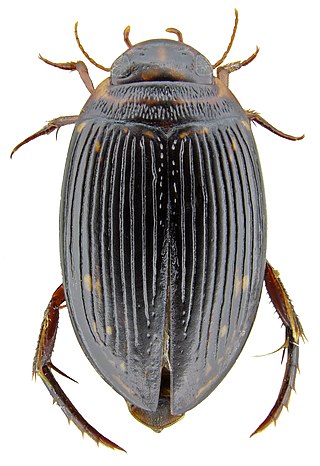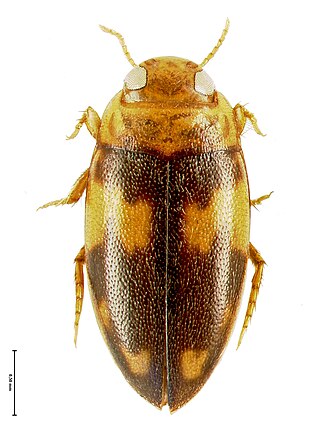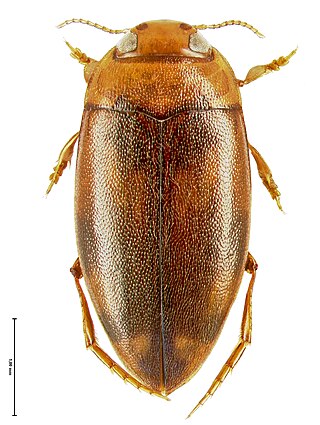Related Research Articles

The Dytiscidae – based on the Greek dytikos (δυτικός), "able to dive" – are the predaceous diving beetles, a family of water beetles. They occur in virtually any freshwater habitat around the world, but a few species live among leaf litter. The adults of most are between 1 and 2.5 cm (0.4–1.0 in) long, though much variation is seen between species. The European Dytiscus latissimus and Brazilian Megadytes ducalis are the largest, reaching up to 4.5 and 4.75 cm respectively. In contrast, the smallest is likely the Australian Limbodessus atypicali of subterranean waters, which only is about 0.9 mm (0.035 in) long. Most are dark brown, blackish, or dark olive in color with golden highlights in some subfamilies. The larvae are commonly known as water tigers due to their voracious appetite. They have short, but sharp mandibles and immediately upon biting, they deliver digestive enzymes into prey to suck their liquefied remains. The family includes more than 4,000 described species in numerous genera.

Platynectes is a genus of beetles in the family Dytiscidae, containing the following species:
Austrodytes is a genus of beetles in the family Dytiscidae found only in northern Australia. It was first described in 1978 by Chris Watts. The genus contains these two species:

Gibbidessus chipi is a species of beetle in the family Dytiscidae, the only species in the genus Gibbidessus.

Limbodessus is a genus of beetles in the family Dytiscidae, first described by Félix Guignot in 1939. It contains the following species:

Antiporus is a genus of beetles in the family Dytiscidae, first described in 1882 by David Sharp, which contains the following species:

Necterosoma is a genus of beetles in the family Dytiscidae, containing the following species:
Nirripirti is a genus of beetles in the family Dytiscidae. However the Australian Faunal Directory considers it a synonym of the genus, Paroster, on the basis of work by Leys and Watts, and Toussaint, Hendrich and others.

Sternopriscus is a genus of beetles in the family Dytiscidae, containing the following species:

Exocelina is a genus of diving beetles in the family Dytiscidae. There are more than 200 described species in Exocelina, found mainly in Oceania, including Australia and New Zealand. 145 of these species have been described from New Guinea.

Neobidessodes is a genus of predaceous diving beetles in the family Dytiscidae. There are about 10 described species in Neobidessodes. They are found in Australasia. The genus was first described in 2009, and the type species is N. denticulatus.
Limbodessus leysi is a carnivorous subterranean water beetle, in the Bidessini tribe of the Dytiscidae family. It was first described in 2006 by Watts and Humphreys, and the species epithet honours the entomologist, Remko Leys.

Neobidessodes flavosignatus is a carnivorous subterranean water beetle, in the Bidessini tribe of the Dytiscidae family. It was first described in 1922 by Albrecht Zimmermann as Bidessus flavosignatus. It was assigned to the genus Bidessodes by Watts in 1978, and to the new genus of Neobidessodes in 2009 by Hendrich and others.

Neobidessodes grossus is a carnivorous subterranean water beetle, in the Bidessini tribe of the Dytiscidae family. It was first described in 1922 by Albrecht Zimmermann as Bidessus grossus. It was assigned to the genus Bidessodes by Watts in 1978, and to the new genus of Neobidessodes in 2009 by Hendrich and others.
Neobidessodes bilita is a carnivorous subterranean water beetle, in the Bidessini tribe of the Dytiscidae family. It was first described in 1978 by Chris H.S. Watts as Bidessodes bilita, and reassigned to the genus of Neobidessodes in 2009 by Hendrich and others.
Paroster caecus is blind beetle in the Hydroporini tribe of the subfamily Hydroporinae in the Dytiscidae family. It was first described by Chris Watts in 1982 as Terradessus caecus. It was transferred to the genus, Paroster, in 2016 by Toussaint, Hendrich and others.
Paroster niger is blind beetle in the Hydroporini tribe of the subfamily Hydroporinae in the Dytiscidae family. It was first described by Chris Watts in 1978.
Paroster arachnoides is water beetle in the Hydroporini tribe of the subfamily Hydroporinae in the Dytiscidae family. It was first described by Chris Watts and William Humphreys in 2004 as Nirripirti arachnoides. It was transferred to the genus, Paroster, in 2008 by Remko Leijs and Chris Watts.
Paroster bulbus is water beetle in the Hydroporini tribe of the subfamily Hydroporinae in the Dytiscidae family. It was first described by Chris Watts and William Humphreys in 2004 as Nirripirti bulbus. It was transferred to the genus, Paroster, in 2008 by Remko Leijs and Chris Watts.
Batrachomatus nannup is a species of diving beetle in the family, Dytiscidae, first described as Allomatus nannup in 1978 by Chris H.S. Watts. The holotype was collected in Bridgetown, Western Australia. In a generic revision in 2013, Lars Hendrich and Michael Balke synonymised AllomatusMouchamps, 1964 with Batrachomatus Clark, 1863, thus changing the species name.
References
- 1 2 3 4 5 6 7 8 9 10 "Australian Faunal Directory: Paroster nameslist". biodiversity.org.au. Retrieved 2022-04-11.
- ↑ Dytiscidae Species List Archived October 23, 2012, at the Wayback Machine at Joel Hallan's Biology Catalog. Texas A&M University. Retrieved on 7 May 2012.